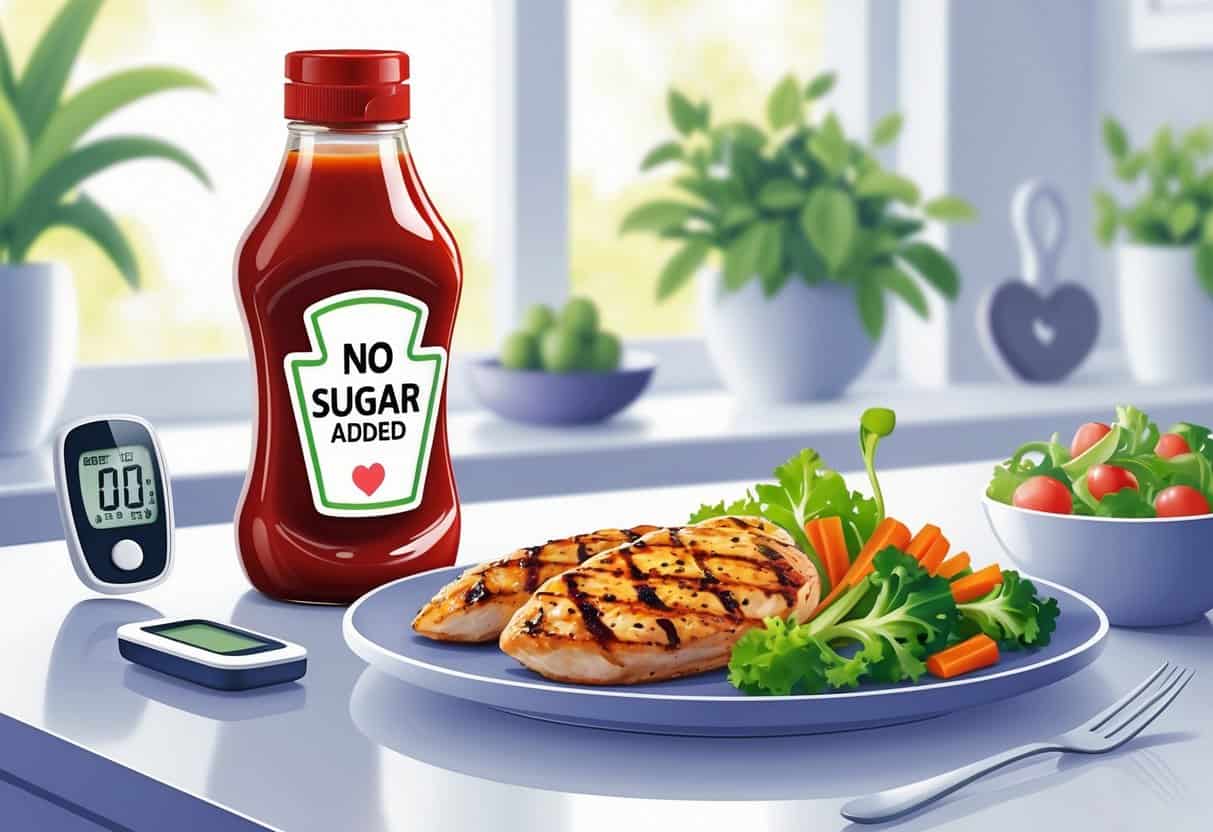If you have diabetes, you might be wondering if ketchup with no sugar added is actually safe. Ketchup without added sugar is generally a better pick for diabetics, since it has fewer carbohydrates that could raise blood sugar levels.
This makes it a smarter choice than regular ketchup, which often has extra sugars that can spike glucose.

Still, not all sugar-free ketchups are the same. Always check the ingredients and nutrition facts, because some brands sneak in substitutes or other additives.
Even sugar-free ketchup should be used in moderation. It’s a condiment, not a main course.
Key Takeaways
- No sugar added ketchup usually has less impact on blood sugar.
- Check labels for hidden sugars or additives.
- Use sugar-free ketchup in moderation as part of a balanced diet.
Understanding Ketchup with No Sugar Added
Ketchup labeled “No Sugar Added” tweaks the recipe by skipping out on extra sweeteners. You’ll spot some differences in ingredients and nutrition compared to regular ketchup.
Ingredients and Nutritional Profile
No sugar added ketchup typically relies on tomatoes as the main ingredient, leaving out things like high fructose corn syrup or plain sugar. You’ll see natural tomato sugars, vinegar, salt, and spices instead.
This type of ketchup generally has fewer carbs and less sugar per serving. For example, a serving might have 1 to 3 grams of sugar, while regular ketchup often has 4 to 5 grams.
Look for phrases like “no added sugars” or “unsweetened” on the label. Pay attention to total carbs—sometimes, other ingredients sneak in extra carbs. Some brands use sugar alcohols or non-nutritive sweeteners to keep the taste up without raising blood sugar.
How No Sugar Added Differs from Regular Ketchup
Regular ketchup usually contains added sugars like high fructose corn syrup, which can push blood sugar up quickly. No sugar added ketchup skips those, so the impact on your blood glucose is smaller.
The flavor might be a bit different, since you lose some sweetness. Some brands try to balance this with more vinegar or spices.
Even so, use ketchup in moderation. No sugar added types still have natural sugars and carbs. Always read the nutrition facts to see how it fits into your diabetes meal plan.
Impact on Blood Sugar and Diabetes Management
Ketchup with no sugar added has fewer carbs and sugars, so it affects your blood sugar differently than the regular stuff. Knowing how it plays into your body’s response can help you manage diabetes a bit better.
Glycemic Index and Glycemic Load
The glycemic index (GI) tells you how fast a food raises your blood sugar. Ketchup with no sugar added usually has a lower GI than regular ketchup, thanks to the reduced sugar content.
Glycemic load (GL) takes both the GI and the amount of carbs into account. Even if the GI is low, eating a lot of ketchup could still bump up your blood sugar. But most people use small servings, so the GL tends to stay low.
Check the nutrition label for the exact carb count. Some brands use sugar substitutes or sweeteners, which can also affect your blood glucose.
Effects on Insulin Response
Your body releases insulin to handle blood sugar after eating carbs. Ketchup without added sugar has fewer carbs, so it usually triggers a smaller insulin spike than regular ketchup.
But if you’re eating ketchup with other carb-heavy foods, the total insulin response could still go up. It’s really about the whole meal, not just the ketchup.
If you track your blood sugar, you might notice smaller changes after using no-sugar-added ketchup. That can make it just a bit easier to stay in your target range.
Considerations for Diabetics Choosing Ketchup
When you’re picking ketchup, pay attention to ingredients, portion size, and the label. These things matter for how ketchup affects your blood sugar.
Artificial Sweeteners and Additives
No sugar added ketchup often uses artificial sweeteners, like sucralose or stevia, instead of sugar. These give you the sweetness without bumping up your blood glucose. Still, some people react differently, so keep an eye out for anything unusual after eating them.
Additives like preservatives or flavor enhancers might also show up. They usually don’t mess with diabetes directly, but it’s smart to check for allergies or sensitivities. If possible, pick brands with fewer additives to avoid extra chemicals.
Artificial sweeteners don’t have carbs, but always check the label. Sometimes, other ingredients can sneak in and affect your health.
Portion Sizes and Daily Intake
A lot of people use more than one tablespoon of ketchup at a time. Even no sugar added ketchup has a little bit of carbs, so portion size still matters.
A tablespoon typically has under 5 grams of carbohydrates. If you use two or three, the carbs add up. Sticking to smaller portions helps keep your glucose steady.
Think about how ketchup fits into your whole meal plan. Keep an eye on your total carb intake to avoid unexpected spikes in blood sugar.
Reading Nutrition Labels
You really should read nutrition labels closely when picking ketchup. Keep an eye on total carbohydrates, sugars, and serving size.
No sugar added ketchup usually clocks in at less than 1 gram of sugar per serving. Of course, that number can bounce around a bit depending on the brand.
Take a peek at the ingredient list. Sometimes condiments claim to be sugar-free but sneak in sugar alcohols or starches that still act like carbs.
Here are the label details that matter most:
- Serving size (how much ketchup counts as a serving)
- Total carbohydrates (affects your blood sugar)
- Sugars and sugar alcohols (what kinds of sweeteners are hiding in there)
If you care about your health or have specific dietary limits, these labels are your best friend.